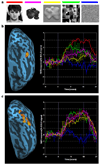What makes faces special?
- PMID: 16938328
- PMCID: PMC2699459
- DOI: 10.1016/j.visres.2006.06.017
What makes faces special?
Abstract
What may be special about faces, compared to non-face objects, is that their neural representation may be fundamentally spatial, e.g., Gabor-like. Subjects matched a sequence of two filtered images, each containing every other combination of spatial frequency and orientation, of faces or non-face 3D blobs, judging whether the person or blob was the same or different. On a match trial, the images were either identical or complementary (containing the remaining spatial frequency and orientation content). Relative to an identical pair of images, a complementary pair of faces, but not blobs, reduced matching accuracy and released fMRI adaptation in the fusiform face area.
Figures









References
-
- Biederman I. Recognition-by-components: a theory of human image understanding. Psychological Review. 1987;94:115–147. - PubMed
-
- Biederman I, Bar M. One-shot viewpoint invariance in matching novel objects. Vision Research. 1999;39:2885–2889. - PubMed
-
- Biederman I, Subramaniam S, Bar M, Kalocsai P, Fiser J. Subordinate-level object classification reexamined. Psychological Research. 1999;62:131–153. - PubMed
Publication types
MeSH terms
Grants and funding
LinkOut - more resources
Full Text Sources

